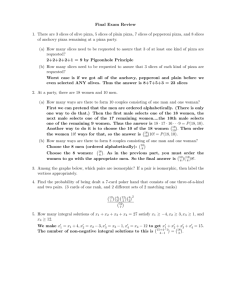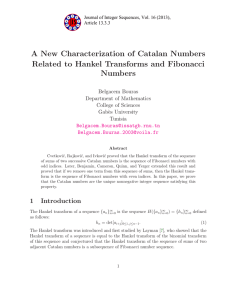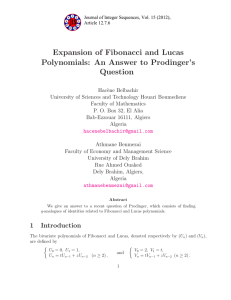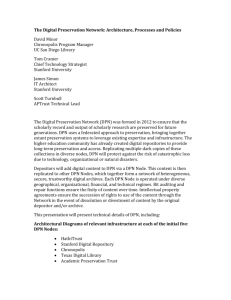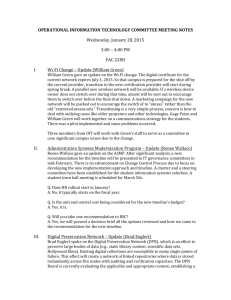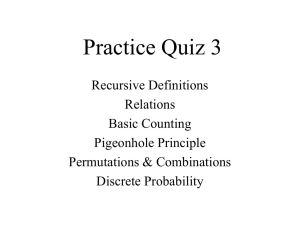Catalan Numbers, the Hankel Transform, and Fibonacci Numbers Article 02.1.3
advertisement
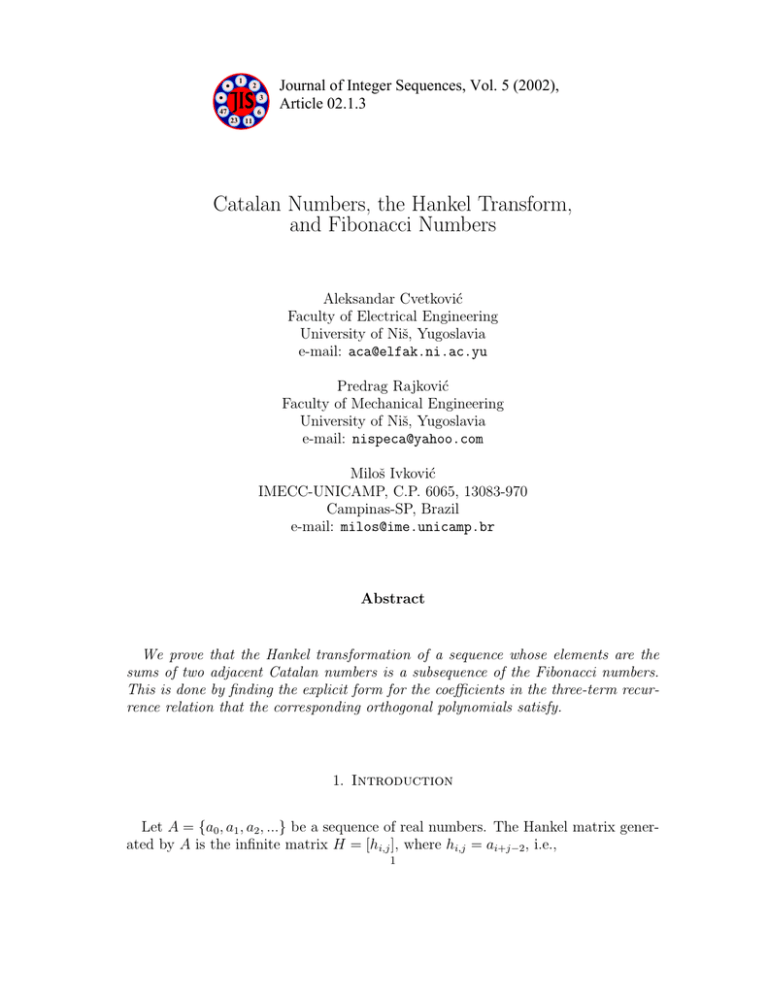
1
2
3
47
6
Journal of Integer Sequences, Vol. 5 (2002),
Article 02.1.3
23 11
Catalan Numbers, the Hankel Transform,
and Fibonacci Numbers
Aleksandar Cvetković
Faculty of Electrical Engineering
University of Niš, Yugoslavia
e-mail: aca@elfak.ni.ac.yu
Predrag Rajković
Faculty of Mechanical Engineering
University of Niš, Yugoslavia
e-mail: nispeca@yahoo.com
Miloš Ivković
IMECC-UNICAMP, C.P. 6065, 13083-970
Campinas-SP, Brazil
e-mail: milos@ime.unicamp.br
Abstract
We prove that the Hankel transformation of a sequence whose elements are the
sums of two adjacent Catalan numbers is a subsequence of the Fibonacci numbers.
This is done by finding the explicit form for the coefficients in the three-term recurrence relation that the corresponding orthogonal polynomials satisfy.
1. Introduction
Let A = {a0 , a1 , a2 , ...} be a sequence of real numbers. The Hankel matrix generated by A is the infinite matrix H = [hi,j ], where hi,j = ai+j−2 , i.e.,
1
2
H=
a0
a1
a2
a3
a4
..
.
a1
a2
a3
a4
a5
..
.
a2
a3
a4
a5
a6
..
.
a3
a4
a5
a6
a7
..
.
...
...
...
...
...
...
The Hankel matrix Hn of order n is the upper-left n × n submatrix of H and
the Hankel determinant of order n of A, denoted by hn , is the determinant of the
corresponding Hankel matrix.
For a given sequence A = {a0 , a1 , a2 , ...}, the Hankel transform of A is the corresponding sequence of Hankel determinants {h0 , h1 , h2 , . . . } (see Layman [5]).
The elements of the sequence in which we are interested (A005807 of the On-Line
Encyclopedia of Integer Sequences (EIS) [10], also INRIA [3]) are the sums of two
adjacent Catalan numbers:
¶
µ ¶
µ
1
2n
2n + 2
1
+
an = c(n) + c(n + 1) =
n+1 n
n+2 n+1
(2n)!(5n + 4)
=
(n = 0, 1, 2, . . .).
n!(n + 2)!
This sequence starts as follows:
2,
3,
7,
19,
56,
174 . . .
In a comment stored with sequence A001906 Layman conjectured that the Hankel transformation of {an }n≥0 equals the sequence A001906, i.e., the bisection of
Fibonacci sequence. In this paper we shall prove a slight generalization of Layman’s
conjecture.
The generating function G(x) for the sequence {an }n≥0 is given by
√
µ
¶
∞
X
1 (1 − 1 − 4x)(1 + x)
n
an x =
−1
G(x) =
x
2x
n=0
(1)
It is known (for example, see Krattenthaler [4]) that the Hankel determinant h n
of order n of the sequence {an }n≥0 equals
2
hn = an0 β1n−1 β2n−2 · · · βn−2
βn−1 ,
(2)
where {βn }n≥1 is the sequence given by:
G(x) =
∞
X
n=0
a0
an x n =
1 + α0 x −
β 1 x2
β x2
1 + α1 x − 1 + α 2x − · · ·
2
(3)
3
The sequences {αn }n≥0 and {βn }n≥1 are the coefficients in the recurrence relation
Pn+1 (x) = (x − αn )Pn (x) − βn Pn−1 (x)
where {Pn (x)}n≥0 is the monic polynomial sequence orthogonal with respect to the
functional L determined by
L[xn ] = an
(n = 0, 1, 2, . . .).
(4)
In the next section this functional is constructed and a theorem concerning the
polynomials {Pn (x)}n≥0 and the sequences {αn }n≥0 and {βn }n≥1 is proved.
2. Main Theorem
We would like to express L[f ] in the form:
L[f (x)] =
Z
f (x)dψ(x),
R
where ψ(x) is a distribution, or, even more, to find the weight function w(x) such
that w(x) = ψ 0 (x).
Denote by F (z) the function
F (z) =
∞
X
ak z −k−1 ,
k=0
From the generating function (1), we have:
(
)
r
¡
1
4
F (z) = z −1 G z −1 ) =
z − 1 − (z + 1) 1 −
.
2
z
(5)
From the theory of distribution functions (see Chihara [1]), we have Stieltjes inversion function
Z
1 t
=F (x + iy)dx.
(6)
ψ(t) − ψ(s) = −
π s
Since F (z̄) = F (z), it can be written in the form
Z th
i
1
F (x + iy) − F (x − iy) dx.
ψ(t) − ψ(0) = −
lim
2πi y→0+ 0
Knowing that
( r
)
r
Z t
1
4
4
F (x + a)dx =
a2 1 − − 2t + 2at + t2 − (a + t)2 1 −
4
a
a+t
0
r
r
³
³
4 ´
4´
−2 log −2 + a + a 1 −
+ 2 log −2 + a + t + (a + t) 1 −
,
a
a+t
(7)
4
we find the distribution function
½
√
´¾
³
p
(4−t)t
1
, 0 ≤ t < 2;
4π t t(4 − t) − 8 π − arctan 2−t
½
¾
√
ψ(t) =
p
(4−t)t
1
t t(4 − t) − 8 arctan t−2
;
2 ≤ t ≤ 4.
4π
After differentiation of ψ(t) and simplification of the resulting expression, we
finally have:
r
1
4
w(x) = (x + 1)
− 1, x ∈ (0, 4).
(8)
2
x
In this way, we obtained the positive-definite L that satisfies (4) and proved that
the corresponding orthogonal polynomial sequence exists. We have
Theorem 1. The monic polynomial sequence {Pn (x)} orthogonal with respect to the
linear functional
r
Z 4
1
4
L(f ) :=
f (x)(x + 1)
− 1dx,
(9)
2π 0
x
satisfies the three-term recurrence relation
Pn+1 (x) = (x − αn )Pn (x) − βn Pn−1 (x),
(10)
with
1
1
, βn = 1 + 2 ,
F2n+1 F2n+3
F2n+1
where Fi is the i-th Fibonacci number.
αn = 2 −
k≥0
(11)
Example 1. The first members of this sequence are:
P0 (x) = 1;
3
P1 (x) = x − ;
2
17
8
P2 (x) = x2 − x + ;
5
5
70
95
21
P3 (x) = x3 − x2 + x − ;
13
13
13
251
290
435
55
P4 (x) = x4 −
x3 +
x2 −
x+ .
34
17
34
34
n
Notice that Pn (0) = (−1) F2n+2 /F2n+1 .
(1/2,−1/2)
Proof of Theorem 1. Denoting by Wn (x) = Pn
(x) (n ≥ 0) a special
Jacobi polynomial, which is also known as the Chebyshev polynomial of the fourth
kind.
The sequence of these polynomials is orthogonal with respect to p(1/2,−1/2) (x) =
(1 − x)1/2 (1 + x)−1/2 on the interval (−1, 1). These polynomials can be expressed
5
(Szegö [9]) by
Wn (cos θ) =
sin(n + 21 )θ
.
2n sin 12 θ
and satisfy the three-term recurrence relation (Chihara [1]):
Wn+1 (x) = (x − αn∗ ) Wn (x) − βn∗ Wn−1 (x) (n = 0, 1, . . .),
W−1 (x) = 0, W0 (x) = 1,
where
1
α0∗ = − ,
2
αn∗ = 0,
β0∗ = π,
βn∗ =
1
4
(n ≥ 1).
If we use the weight function p̂(t) = (t − c)p(1/2,−1/2) (t), then the corresponding
coefficients α̂n and β̂n can be evaluated as follows (see, for example, Gautschi [2])
Wn+1 (c)
Wn (c)
∗
− βn+1
,
(12)
α̂n = c −
Wn (c)
Wn+1 (c)
Wn−1 (c)Wn+1 (c)
, n ∈ N.
Wn2 (c)
Here, we use c = −3/2 and p̂(x) = (x + 3/2)(1 − x)1/2 (1 + x)−1/2 .
β̂n = βn∗
(13)
If we write λn = Wn (−3/2) then, using the three-term recurrence relation for
Wn (x), we have
4λn+1 + 6λn + λn−1 = 0,
with initial values λ0 = 1, λ1 = −1.
So, we find
√ n
√ no
√
(−1)n n √
√
λn = Wn (−3/2) =
( 5 + 1)(3 + 5) + ( 5 − 1)(3 − 5) .
2 5 4n
Denoting by
√
√
1− 5
1+ 5
,
φ=
φ=
2
2
the golden section numbers, we can write:
(−1)n
(−1)n 2n+1
2n+1
λn = Wn (−3/2) = √
)=
F2n+1 .
(φ
−φ
2n
5 2n
(14)
(15)
In order to simplify further algebraic manipulations we shall use
2
+1
F2n−1 F2n+3 = F2n+1
(16)
This formula is a special case of the identity (Vajda [12]):
G(n + i)H(n + k) − G(n)H(n + i − k) = (−1)n (G(i)H(k) − G(0)H(i + k)) (17)
where G and H are sequences that satisfy the same recurrence relation as the Fibonacci numbers with possibly different initial conditions. However, we take both
G and H to be the Fibonacci numbers and n → 2n + 1, i = 2, k = −2.
6
Now
1 λn−1 λn+1
1 F2n−1 F2n+3
=
2
4
λ2
4 F2n+1
½ n
¾
1
1
1+ 2
=
4
F2n+1
β̂n =
(18)
and
3 λn+1 1 λn
−
α̂n = − −
2
λn
4 λn+1
2
2
−3F2n+1 F2n+3 + F2n+3
+ F2n+1
=
2F2n+1 F2n+3
2
F2n+2 − F2n+1 F2n+3
=
2F2n+1 F2n+3
1
= −
.
2F2n+1 F2n+3
If a new weight function p(x) is introduced by
p(x) = p̂(ax + b)
then we have
α̂n − b
β̂n
(n ≥ 0).
,
βn = 2
a
a
Now, by using x 7→ x/2 − 1, i.e., a = 1/2 and b = −1, we have the wanted weight
function
r
4−x
1
x
.
w(x) = p̂( − 1) = (x + 1)
2
2
x
αn =
Thus
αn = 2 −
and
5
(φ2n+1 − φ
βn = 1 +
finishing the proof of (1) .¤
2n+1
)(φ2n+3 − φ
2n+3
5
(φ2n+1 − φ
2n+1
)2
)
=2−
=1+
1
F2n+1 F2n+3
1
2
F2n+1
(19)
(20)
3. Layman’s conjecture
By making use of (2) we have that:
hn =
an0
¶n−1 µ
¶n−2 µ
¶
µ
1
1
1
1+ 2
··· 1 + 2
1+ 2
F3
F5
F2n−1
(21)
7
Using (16) we can write (21) as:
µ
¶n−1µ
¶n−2µ
¶n−3
F1 F5
F3 F7
F5 F9
F2n−3 F2n+1
n
hn = a0
···
2
2
2
2
F3
F5
F7
F2n−1
(22)
Since a0 = 2 = F3 the corresponding factors cancel, therefore:
hn = F2n+1
(n ≥ 0),
thus proving that Hankel transform of A005807 equals A001519 -sequence of Fibonacci numbers with odd indices.
As we have mentioned in the introduction, Layman observed that the Hankel
transform of A005807 equals A001906 -sequence of Fibonacci numbers with even
indices. This sequence is obtained if we start the Hankel matrix from a1 = 3, i.e.,
determinants will have a1 on the position (1, 1).
The proof of this fact is almost identical with the proof presented here, and
so we do not include it. Notice that now we construct L[xn ] = an+1 and that
a1 = 3 = F4 ; in (17) we take n → 2n. We also use the easily provable fact
Pn (0) = (−1)n F2n+2 /F2n+1 (see Example 1).
Finally we mention that, following Layman [5], it is known that the Hankel transform is invariant with the respect to the Binomial and Invert transform, so all the
sequences obtained from A005807 using these two transformations have the Hankel
transform shown here.
References
[1] T. S. Chihara, An Introduction to Orthogonal Polynomials, Gordon and Breach, New York,
1978.
[2] W. Gautschi, Orthogonal polynomials: applications and computations, in Acta Numerica,
1996, Cambridge University Press, 1996, pp. 45–119.
[3] INRIA Algorithms Project, Encyclopedia of Combinatorial Structures,
at http://algo.inria.fr/bin/encyclopedia?Search=ESCnb&argseach=431.
[4] C. Krattenthaler, Advanced Determinant Calculus,
at http://www.mat.univie.ac.at/People/kratt/artikel/detsurv.html.
[5] J. W. Layman, The Hankel Transform and Some of its Properties, Journal of Integer Sequences, Article 01.1.5, Volume 4, 2001.
[6] P. Peart and W. J. Woan, Generating functions via Hankel and Stieltjes matrices, Journal of
Integer Sequences, Article 00.2.1, Issue 2, Volume 3, 2000.
[7] W. J. Woan, Hankel Matrices and Lattice Paths, Journal of Integer Sequences, Article 01.1.2,
Volume 4, 2001.
[8] J. P. O. Santos and M. Ivković, Fibonacci numbers and partitions, Fibonacci Quarterly, to
appear.
[9] G. Szegö, Orthogonal Polynomials, AMS, 4th. ed., Vol. 23 (Colloquium publications), 1975.
[10] N. J. A. Sloane, The On-Line Encyclopedia of Integer Sequences. Published electronically at
http://www.research.att.com/∼njas/sequences/.
[11] R. Tosić, Kombinatorika (in Serbian) Univerzitet u Novom Sadu (1999), Novi Sad.
[12] S. Vajda, Fibonacci and Lucas numbers, and the Golden Section: Theory and Applications,
Halsted Press, 1989.
8
[13] D. Zeilberger and T. Amdeberhan, DODGSON: A Maple package for conjecturing and proving
determinant identities by Dodgson’s condensation method,
at http://astro.ocis.temple.edu/ doron/programs.html.
(Mentions sequences A005807, A001906, A001519.)
Received April 8, 2002; revised version received May 14, 2002. Published in Journal
of Integer Sequences May 14, 2002.
Return to Journal of Integer Sequences home page.
